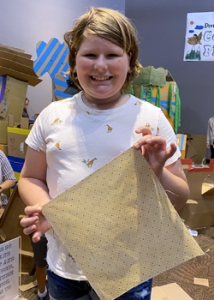
Thousands packed the ʻImiloa Astronomy Center at the University of Hawaiʻi at Hilo to celebrate the educational center’s 14th birthday on February 23. Visitors engaged in hands-on activities, planetarium shows, presentations and exhibits on ways to recycle, reuse and reduce waste. This year’s celebration was focused on mālama ʻāina or caring for the land.
“With all that we are experiencing globally, it is ʻImiloa’s hope that visitors take with them a heightened awareness of the waste and debris as a result of our collective impact here on Earth and in space,” said ʻImiloa executive director, Kaʻiu Kimura.

Visitors learned everything from how to properly decompose food to reusing items that would typically go straight into the trash. Hundreds of keiki were among the approximately 2,000 attendees at ʻImiloa’s celebration. Many waited eagerly in line for a chance to make beeswax wraps. The popular do-it-yourself activity required participants to melt down edible wax slathered over fabric. The wrap is meant to replace plastic wrap to cover food.
Loa Grabowski, 10, said she can’t wait to make use of her creation. “I especially enjoyed making the beeswax wrap because I can use them for my school lunch everyday,” Grabowski said.
Mālama ʻāina educational efforts extended beyond Earth, to outer space. Visitors enjoyed a full dome presentation in ʻImiloa’s planetarium which featured a special show, Space Junk, addressing the various satellites orbiting around Earth and the discussions taking place on how to clean-up scattered debris.
KTA Super Stores sponsored free admission to ʻImiloa’s birthday celebration. The Hawaiʻi Island supermarket chain has been a longtime supporter of the center.
Merging culture and science
Each year, ʻImiloa welcomes about 100,000 visitors to its 12,000-square-foot exhibit hall that focuses on educating the public on parallels between Hawaiian culture and western science.
“I hope visitors come away with more enlightened minds and hearts, knowing that culture is a vital part of science and that science exists deeply in our culture. It is my heartfelt hope for ʻImiloa to be a beacon of science and cultural integration that honors the importance of nurturing diversity, showcasing how indigenous culture serves as a vital resource to help propel our community forward and upward,” Kimura said.
The center’s work was recently highlighted in the Nature Astronomy journal.
Learn more about the ʻImiloa Astronomy Center at UH News.
—By Moanikeʻala Nabarro


